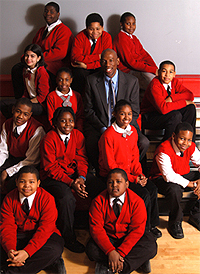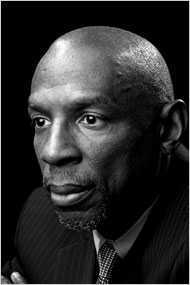Earlier this year I read Work Hard, Be Nice which describes the development of the KIPP (Knowledge is Power Program) Charter Schools. This book concerns a similar but even more radical approach to the problem of educating underprivileged students, and the one endorsed by President Obama: The Harlem Children’s Zone (HCZ).
The author, who covered the project’s first five years for the New York Times Magazine, thoroughly documents the nature of poverty in black America to give readers a sense of what founder HCZ Founder Geoffrey Canada was up against. While this book is rigorously researched, it does not read like a sociological treatise. Rather, it is engrossing and engaging, and has you rooting not only for Geoffrey Canada but also for the people of Harlem who so generously shared their struggles with the author.
In 1999, Geoffrey Canada began planning a poverty-fighting project that would cover the twenty-four-block zone of central Harlem (eventually expanded to a ninety-seven block area) with the biggest problems: crushing poverty, unemployment, crime, high homicide rates, young single parents, bad schools, and children who were for the most part doomed to failure.
The statistics of the HCZ were grim. More than 60% of children lived below the poverty line, and three-quarters of them scored below grade level in reading and math. Tough writes:
“The average white family in Manhattan with children under five … had an annual income of $284,000, while their black counterparts made an average of $31,000. Growing up in New York wasn’t just an uneven playing field anymore. It was like two separate sporting events.”
Canada’s idea was to create a safety net for these children, to save them from more poverty, from prisons, or even an early death. He started with a third grade, and was shocked and overwhelmed to see all the parents who swamped the auditorium in Harlem for the first lottery drawing to reserve a space in “The Promise Academy.” One of the most stirring passages in this book is the speech made by a friend of Canada’s, the Reverend Alfonso Wyatt, to these Harlem parents:
“I want to tell you something that maybe you don’t know. … The people who run prisons in this country are looking at our third-graders. They look at their test scores each year to begin to predict how many prison cells will be needed twenty years from now. … And so I want the people in this house to tell them: You will not have our children!… ‘Let me hear somebody say it,’ Wyatt called out, and he led the crowd in a chant: ‘You! Will! Not! Have! Our! Children!’”
Canada wanted these kids to have the same chances as the kids in Manhattan. But his goal was daunting. Researchers found the dysfunction of ghetto families to be the result of generations of discrimination, isolation, and cultural decay. As a result, ghetto residents tend not to qualify for many jobs in the modern economy that require high levels of education and technical expertise, and the lethal vortex of poverty continues to hold them in its grasp.
Most importantly from Canada’s standpoint, decades of study reveal that the difference in academic achievement begins very early – before kindergarten! Tough reports:
“By middle school, the gap between avid readers and reluctant readers has grown into a chasm.”
Much of the gap stems from the depth of exposure to language: not only is the number of words the child hears important, but the kind of words and statements (“encouragements” versus “discouragements”) as well.
Cognitive skills have a complement in non-cognitive skills (also lacking in the poor) that also confer advantages in both education and in the job market. These include: the confidence to deal with institutions, authorities, and situations; patience; persistence; ability to follow instructions; ability to delay gratification; and the sense of entitlement that comes from positive parental involvement in both children’s education and in activities and recreations. Training for both kinds of skills is an integral part of The Promise Academy.
In sum, to change the trajectory of a poor child in an inner-city neighborhood, research shows you need to do the following:
1. intervene early in the child’s life
2. continue to intervene throughout adolescence
3. give him extra time in school and extra support outside of school
4. involve his parents if possible but be prepared to compensate for their absence
5. focus on improving his cognitive skills but also nurture his non-cognitive, social, and emotional skills
Finding that advantages as well as disadvantages accumulate, Canada decided – when he was finally able to expand – to begin his program with a “Baby College” for prospective parents. From there, kids went to the Three-Year-Old Journey, then Harlem Gems prekindergarten, and then on to the Promise Academy. Canada called this the conveyor-belt approach:
“The way Canada sees it, the middle-class children he wants Harlem’s kids to compete with are surrounded by a cocoon of support – educational support, emotional support, medical support – that starts at birth and never stops.”
He describes his project’s aims using a basic principle of Newtonian physics: what he wants to do is build enough positive momentum so that kids can escape the downward spiral of poverty in Harlem and reach “escape velocity.” What he does not want to do, however – and here is how he differs from KIPP – is to strip the kids of the good aspects of their black or Spanish cultures. Rather, he wants to “contaminate” Harlem with positives and combine the best of both worlds.
Canada emphasizes that one could say the desire to help the poor has nothing to do with “morality.” In fact, he avers, is in the country’s best interest to help these kids: it will save money on the costs of social programs for the poor, and add tax money from more workers.
Fittingly, the book ends with the creed that the students of the Promise Academy recite:
“I promise to always dream out loud, to lift my head and be proud. And never end up a face in the crowd.”
Note: As of the author’s writing in June, 2009, Congress had not approved the White House’s request for planning grants to go to community-based non-profits interested in applying to start a Promise Neighborhood.
Evaluation: I have always been interested in the enduring problem of poverty, as well as the challenges of education. If either or both of these subjects interest you, I believe you will find this book quite rewarding. You can also learn more about the Harlem Children’s Zone on its website, here.
Rating: 4/5
Published by Houghton Mifflin Harcourt, 2008












This sounds just fascinating!! I’m on my way over the the library website…
It’s still unbelievable to me that we can’t help more of these children. I think this book sounds fascinating!
It is so sad but the primary hurdle facing these children and others like them is ideology. It’s not that there are all these children struggling to do well in school and go to college; it’s that there are all these children who from day one believe education is not for them, is uncool, or is too difficult. And no one tells them any different. That is one serious obstacle to overcome, and then even if you do get some people on board the education bus, you still have to teach them to drive it and how to handle the potholes.
Okay, I should stop my rambling now. I teach at a community college, and a large chunk of the student population is lower-middle or lower class whites and blacks. I am consistently surprised and saddened by what those students miss out on for the first 12 years of their education, how far behind some of them are.
The message of this book is so powerful. I can think of several groups of people in our society that should be reading it. I’ll start with myself.
I love books like this and tend to go on and on about them as I read them, much to everyone else’s chagrin. This sounds right up my alley.
Brilliant idea. This is a “have-to” read…Thank you.
It’s great that Canada doesn’t want to take away the positive aspects of these kids’ culture. How does he manage that, does he say? What he does differently to other schools?
Jenny,
There are some values in the poor neighborhoods Canada wants to keep, such as being race-conscious and proud, and devoted to the block and the neighborhood. By not wanting to take from these kids the positive aspects of Harlem, what Canada means is not to take them out of Harlem and put them into elite boarding schools in other locations so that they become alienated from their own neighborhood and background. He “wants to leave Harlem’s poor children exactly where they are, so that they change the neighborhood and the neighborhood changes them.”
I got a tear in my eye reading this review. Disparity in education always upsets me when the subject comes up. I hope some success stories are included in this book. That is, I am sure there are some sucess stories, but I get cheered when I read them. I’ll be looking for this book!
Valerie,
Yes there are success stories although the project isn’t that old yet. But getting to know some of the kids in the parenting classes and reading about the elevated test scores were some of the best parts of the book!
Those two subjects most definitely do interest me, so I’ll pick this up for sure. It’s so true that both advantages AND disadvantages accumulate, and it can be SO easy to just dismiss kids who only had the latter as “not trying hard enough”… Which really, really upsets me.
This books looks fantastic. Thank you for including so much information. Pverty and education are two things that interest me as well.
God bless people like Mr. Canada who do this kind of work. They are up against so many odds… but if he was able to help even a handful of kids achieve better lives, then all his work is worthwhile. Great review … very inspiring. And it makes me appreciate just how damn lucky I am (and my kid is).
Poverty and education are two subjects high on my interest list. I find the KIPP program fascinating (and those teachers are *driven*!) … I just didn’t care for the droning in the book.
I hadn’t heard of Canada’s work (how can that be); thanks for bringing him and this book to my attention.
The motto you quoted at the end is applicable to all children (even with the split infinitive!)